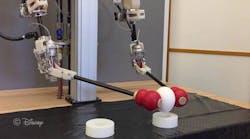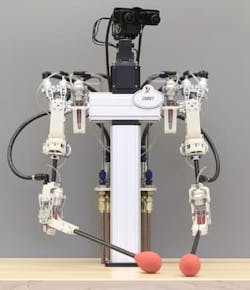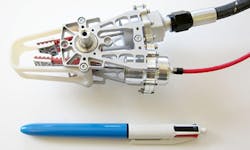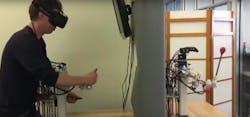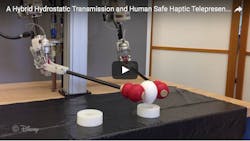Hydraulics and pneumatics technologies are two widely used methods of power transmission. Hydraulics is most often used for its ability to move heavy loads with highly controlled motion, whereas pneumatics is more often associated with applications involving lighter loads and rapid, repetitive motions.
Many machines use hydraulic, pneumatic, and electromechanical systems, and you'll often see pneumatic or pneumatic systems integrated with electromechanical drives. But you'll rarely see hydraulic and pneumatic systems working in an integrated system.
Air and Oil Usually Don't Mix
When pneumatic and hydraulic systems are paired together, they are usually called air-over-oil systems. In most cases, compressed air is used as an energy source to drive the hydraulic system. This may involve an air-driven hydraulic pump, often referred to as an intensifier.
In a huge departure from convention, a Disney Research team led by John P. Whitney, assistant professor at Northeastern University's College of Mechanical and Industrial Engineering, Boston, has come up with a hybrid hydraulic-pneumatic system to create surprisingly lifelike motions while maintaining precise force control.
The system uses a series of rolling-diaphragm cylinders that use hydraulic power to move in one direction and compressed to move in the other. Two single-acting cylinders are paired to form a single rotary actuator. Essentially, force from the air cylinder creates a preload against the hydraulic cylinder. The compressed air in the one cylinder provides the return force that would otherwise be provided by a spring. Each cylinder, then, requires only one hydraulic line and one pneumatic line. The result is a system that the team describes as light, fast, and dexterous, with low friction and no backlash.
Mimicking Human Movement
For the latest version of the system, Disney Research built a human-safe, humanoid robot consisting of an upper torso with two arms and a head carrying stereo cameras. Each arm has four degrees of motion.
Using a virtual-reality headset for visual input from the robot's stereo cameras, an operator manipulates arms of a remote controller, and the robot follows the moves precisely in real time. The headset lets the operator see through the robot's eyes, and dual-axis motion of its head follows the movements of the operator's head via electric servos.
The low-impedance hydraulic system provides haptic feedback for precise enough control for delicate tasks, such as picking up a raw egg or even threading a needle. It consistently transmits contact forces to the operator while generating a high-fidelity remote sense of touch using haptic feedback.
"The transmission provides our robot with incredibly smooth and fast motion while also allowing life-like interaction with people and the handling of delicate objects," says Jessica Hodgins, vice president at Disney Research and a professor of robotics at Carnegie Mellon University, Pittsburgh. "For now, the robot is remotely controlled by a human operator, but we would expect the same level of mechanical performance once the motions are automated."
The team's results were presented yesterday at the IEEE Conference on Robotics and Automation (ICRA 2016) in Stockholm. Click here to download a PDF of the technical paper, "A Hybrid Hydrostatic Transmission and Human – Safe Haptic Telepresence Robot."
